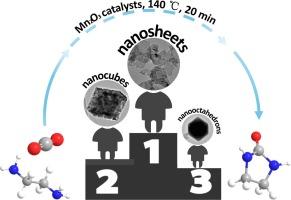纳米α-Mn2O3在CO2直接合成乙脲中的形状依赖性活性
IF 5.9
3区 工程技术
Q1 CHEMISTRY, MULTIDISCIPLINARY
Journal of Industrial and Engineering Chemistry
Pub Date : 2025-04-11
DOI:10.1016/j.jiec.2025.04.023
引用次数: 0
摘要
将二氧化碳直接转化为高价值化学品是减缓温室气体的可持续途径。虽然形态依赖的催化活性在氧化反应中被广泛探索,但其在二氧化碳基尿素合成中的作用仍然未知。在此,我们系统地研究了形状控制α-Mn2O3催化剂(纳米片/NS、纳米立方/NC、纳米八面体/NO)在由二氧化碳和乙二胺(EDA)合成乙尿素(EU)中的构效关系。Mn2O3-NS催化剂达到了破纪录的效率(在140°C下,20分钟内EDA转化率为96%,EU选择性为95%),超过了所有报道的催化剂。通过XRD, XPS, CO2/NH3-TPD和TEM分析,我们确定了Mn2O3-NS的优越性能源于其丰富的表面氧空位(22.5%)和更多的强酸碱位点,这些特征与其纳米片的形貌密切相关。这项工作不仅提供了对形貌控制的CO2活化机制的基本见解,而且还推进了工业CO2增值锰基催化剂的合理设计。本文章由计算机程序翻译,如有差异,请以英文原文为准。

Shape-dependency activity of Nanostructured α-Mn2O3 in direct synthesis of ethylene urea from CO2
The direct conversion of CO2 into high-value chemicals presents a sustainable pathway for greenhouse gas mitigation. While morphology-dependent catalytic activity has been widely explored in oxidation reactions, its role in CO2-based urea synthesis remains uncharted. Herein, we systematically investigate the structure–activity relationship of shape-controlled α-Mn2O3 catalysts (nanosheets/NS, nanocubes/NC, nanooctahedrons/NO) for synthesizing ethylene urea (EU) from CO2 and ethylenediamine (EDA). The Mn2O3-NS catalyst achieves record-breaking efficiency (96 % EDA conversion, 95 % EU selectivity in 20 min at 140 °C), surpassing all reported catalysts. Through combined XRD, XPS, CO2/NH3-TPD, and TEM analyses, we establish that the superior performance of Mn2O3-NS originates from its abundant surface oxygen vacancies (22.5 %) and more strong acid-base sites – features critically linked to its nanosheet morphology. This work not only provides fundamental insights into morphology-governed CO2 activation mechanisms but also advances the rational design of manganese-based catalysts for industrial CO2 valorization.
求助全文
通过发布文献求助,成功后即可免费获取论文全文。
去求助
来源期刊
CiteScore
10.40
自引率
6.60%
发文量
639
审稿时长
29 days
期刊介绍:
Journal of Industrial and Engineering Chemistry is published monthly in English by the Korean Society of Industrial and Engineering Chemistry. JIEC brings together multidisciplinary interests in one journal and is to disseminate information on all aspects of research and development in industrial and engineering chemistry. Contributions in the form of research articles, short communications, notes and reviews are considered for publication. The editors welcome original contributions that have not been and are not to be published elsewhere. Instruction to authors and a manuscript submissions form are printed at the end of each issue. Bulk reprints of individual articles can be ordered. This publication is partially supported by Korea Research Foundation and the Korean Federation of Science and Technology Societies.

 求助内容:
求助内容: 应助结果提醒方式:
应助结果提醒方式:


